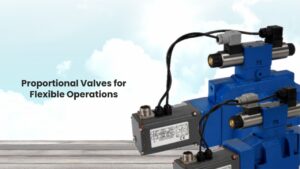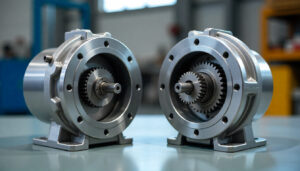Choosing the right track motor for excavator use is one of the most important decisions an operator or equipment owner can make. The performance of your machine in terms of digging power, travel speed, and stability depends heavily on the quality and excavator track motor torque specifications.
of its track motor. Whether you are looking for a high torque track motor for excavator applications or trying to understand the best excavator track motor torque specifications for your worksite, making an informed choice can save you time, fuel, and costly repairs.
This comprehensive track motor buying guide for excavators will help you understand how power, speed, and torque work together and how each factor impacts your excavator’s efficiency. By the end, you will know exactly what to look for in a track motor so you can match it perfectly to your machine and your operating conditions.
What Is a Track Motor (Final Drive) in an Excavator?
The track motor, also known as the final drive motor, is what actually converts hydraulic energy into mechanical motion. This is what allows the excavator to move forward and backward, and it works just like a car, turning and such. No track motor is working, and even the most state-of-the-art excavator will come to a complete halt.
Track motors can be very different in terms of dimensions, power output, gear ratios, and torque. If the track motor is matched properly to the excavator’s hydraulic system and workload requirements, it should provide years of dependable service with little or no maintenance. Incorrect selection can result in over-application, decreased efficiency, and a costly period of downtime.
Why Power Matters in Excavator Track Motors
Power is a measure of how much work a track motor can do in a certain interval of time. For excavators, this is measured as a ratio of hydraulic input to mechanical output from the motor driving the wheels. Power (how well your machine will push, climb a slope, or travel in mud and rugged terrain)
For use in heavy-duty excavators, it is essential that the output motor can withstand high hydraulic flow rates without overheating or compromising performance. That being said, it is usually one of the trade-offs for higher power. Hence, you need to balance between the power you need and the running cost you are willing to bear.
A more powerful motor is necessary if you operate on steep hills frequently or haul heavy loads long distances. However, for relatively lighter excavation work, moderate power would be handled efficiently to reduce energy costs.
Speed Considerations for Track Motor Selection
Track motors are often misunderstood in terms of speed. Although it can be an attractive proposition to select your motor based on maximum travel speed, faster is certainly not always better! Vehicle mobility is basically speed, given that the excavator is moving from one point to the next, though greater speed can cause greater reduction in torque output for a given motor unless the correct gear ratios have been placed in the design.
If you are working on large job sites and continuously relocating the machine, a higher speed could make your life easier. On the other hand, in the case of heavy digging works, lower speeds with a high torque track motor for excavator output often provide optimal control and stability.
When it comes to excavators, a good track motor buyer’s guide will always advocate for a balance between speed and torque. For instance, two-speed final drives let you switch between high-speed travel and low-speed torque as needed.
The Importance of Torque in Excavator Performance
Torque While torque is possibly the most critical spec when it comes to choosing a track motor, this is associated with the torque that the motor output can provide, and affects the performance of the excavator to push, pull, and climb.
High torque track motor for an excavator is most suited for the wild environment, such as muddy land or steep slopes, or when working with heavy attachments. Without high torque, the excavator will stall, or the hydraulic system will be forced to work hard to move it under load.
When examining excavator track motor torque specs, keep an eye out for units that deliver plentiful torque over a wide band of speeds. So your machine can be as versatile as it should be: you can still do the heavy pushing, and then quickly travel when you need to.
The torque depends on the gear ratios, motor displacement, and hydraulic pressure. Motors with larger displacements tend to be torquey but operate at lower RPMs, which brings us to the need to understand the requirements of your application.
Scale Up or Scale Down Motor Spec to Fit on Your Excavator
Make sure the motor size, power, and torque rating match the hydraulics of the excavator. An oversized motor can swamp your hydraulics, and it will underperform.
Check the excavator track motor torque specifications carefully
Your most extreme operational conditions exert the torque specs for the excavator track motor. For instance, forestry or quarry work sometimes requires maximum torque and low speeds, while landscaping more requires a smooth operation and high speeds.
Consider the operating environment
Places where mud, rocks, or steep slopes require more torque and are rugged. These environments require motors with enhanced seals and rugged gear designs to ensure durability.
Look for two-speed functionality
Flexibility is the key to success; a track motor that lets you switch between high torque and high speed gives you the flexibility to manage multiple job types without changing components.
Evaluate maintenance and parts availability
Select a motor that has easy replacement parts and maintenance routines. This reduces maintenance delays and allows your device to work for longer.
Common Mistakes When Selecting an Excavator Track Motor
Speed for Speed’s Sake: A powerful, fast, low-torque motor may find you stuck in the mud
Not Matching Hydraulic Compatibility: Putting in a motor that has an incompatible flow or pressure rating will destroy not only the motor, but also your excavator.
Ignoring Build Quality: Build quality matters; low-quality materials and bad sealing lead to premature wear, leaks, and expensive repairs.
Not Checking Manufacturer Data: Always refer to the specs and, if possible, talk to the manufacturer or the supplier.
Final Buying Tips and Recommendations
After you have filtered your options regarding power, speed, and torque, compare different brands and models regarding features, reliability, and post-sale support. Many prospective buyers find that reading reviews from other operators in similar industries can be an incredibly valuable, real-world resource.
Do not ignore warranty terms and technical support. It should come backed by both detailed technical documentation and responsive customer service, depending on what you look for in a reliable supplier.
Bottom Line
To select the ideal track motor for your stiff reading excavator use, you will have to weigh the power, speed, and torque against each other to ensure that they correspond with your equipment capacity and the demands of your job. Knowing how all these factors affect performance helps you to make a decision that improves productivity and minimizes downtime while providing long-term value.
THM Huade high-quality track motors are ideal for operators looking for proven performance, precision engineering, and durability. Engineered to demanding industrial standards. Choose the right one, and your excavator will be ready to take on anything you throw at it, from mighty pushing power to fast and steady high-speed travel.
FAQs
Torque for excavators: How do I know a track motor has enough?
Refer to the manufacturer's excavator track motor torque specs. Weigh that against the hydraulic output of your machine and the requirements of your average job site.
Are two-speed track motors worth the cost?
Yes. Offering the option to travel at high speed as well as dig or climb at high torque, two-speed motors can make your excavator more versatile.
How frequently do I need to service the track motor on my excavator?
Inspection and maintenance should occur as recommended by your manufacturer. This usually involves inspecting seals, lubrication, and hydraulic connections every few hundred operational hours.



